+ Open data
Open data
- Basic information
Basic information
| Entry | Database: PDB / ID: 7pe2 | ||||||
|---|---|---|---|---|---|---|---|
| Title | Cryo-EM structure of BMV-derived VLP expressed in E. coli (eVLP) | ||||||
 Components Components | Coat protein | ||||||
 Keywords Keywords | VIRUS LIKE PARTICLE / BMV / brome mosaic virus / capsid proteins | ||||||
| Function / homology | Bromovirus coat protein / Bromovirus coat protein / viral capsid / structural molecule activity / Coat protein Function and homology information Function and homology information | ||||||
| Biological species |   Brome mosaic virus Brome mosaic virus | ||||||
| Method | ELECTRON MICROSCOPY / single particle reconstruction / cryo EM / Resolution: 3.2 Å | ||||||
 Authors Authors | Ruszkowski, M. / Strugala, A. / Indyka, P. / Urbanowicz, A. | ||||||
| Funding support | 1items
| ||||||
 Citation Citation |  Journal: Nanoscale / Year: 2022 Journal: Nanoscale / Year: 2022Title: Cryo-EM reconstructions of BMV-derived virus-like particles reveal assembly defects in the icosahedral lattice structure. Authors: Milosz Ruszkowski / Aleksander Strugala / Paulina Indyka / Guillaume Tresset / Marek Figlerowicz / Anna Urbanowicz /   Abstract: The increasing interest in virus-like particles (VLPs) has been reflected by the growing number of studies on their assembly and application. However, the formation of complete VLPs is a complex ...The increasing interest in virus-like particles (VLPs) has been reflected by the growing number of studies on their assembly and application. However, the formation of complete VLPs is a complex phenomenon, making it difficult to rationally design VLPs with desired features . In this paper, we describe VLPs assembled from the recombinant capsid protein of brome mosaic virus (BMV). The analysis of VLPs was performed by Cryo-EM reconstructions and allowed us to visualize a few classes of VLPs, giving insight into the VLP self-assembly process. Apart from the mature icosahedral VLP practically identical with native virions, we describe putative VLP intermediates displaying non-icosahedral arrangements of capsomers, proposed to occur before the final disorder-order transition stage of icosahedral VLP assembly. Some of the described VLP classes show a lack of protein shell continuity, possibly resulting from too strong interaction with the cargo (in this case tRNA) with the capsid protein. We believe that our results are a useful prerequisite for the rational design of VLPs in the future and lead the way to the effective production of modified VLPs. | ||||||
| History |
|
- Structure visualization
Structure visualization
| Movie |
 Movie viewer Movie viewer |
|---|---|
| Structure viewer | Molecule:  Molmil Molmil Jmol/JSmol Jmol/JSmol |
- Downloads & links
Downloads & links
- Download
Download
| PDBx/mmCIF format |  7pe2.cif.gz 7pe2.cif.gz | 4.4 MB | Display |  PDBx/mmCIF format PDBx/mmCIF format |
|---|---|---|---|---|
| PDB format |  pdb7pe2.ent.gz pdb7pe2.ent.gz | Display |  PDB format PDB format | |
| PDBx/mmJSON format |  7pe2.json.gz 7pe2.json.gz | Tree view |  PDBx/mmJSON format PDBx/mmJSON format | |
| Others |  Other downloads Other downloads |
-Validation report
| Summary document |  7pe2_validation.pdf.gz 7pe2_validation.pdf.gz | 2.6 MB | Display |  wwPDB validaton report wwPDB validaton report |
|---|---|---|---|---|
| Full document |  7pe2_full_validation.pdf.gz 7pe2_full_validation.pdf.gz | 2.7 MB | Display | |
| Data in XML |  7pe2_validation.xml.gz 7pe2_validation.xml.gz | 617 KB | Display | |
| Data in CIF |  7pe2_validation.cif.gz 7pe2_validation.cif.gz | 942.2 KB | Display | |
| Arichive directory |  https://data.pdbj.org/pub/pdb/validation_reports/pe/7pe2 https://data.pdbj.org/pub/pdb/validation_reports/pe/7pe2 ftp://data.pdbj.org/pub/pdb/validation_reports/pe/7pe2 ftp://data.pdbj.org/pub/pdb/validation_reports/pe/7pe2 | HTTPS FTP |
-Related structure data
| Related structure data |  13345MC  7pe1C M: map data used to model this data C: citing same article ( |
|---|---|
| Similar structure data |
- Links
Links
- Assembly
Assembly
| Deposited unit | 
|
|---|---|
| 1 |
|
- Components
Components
| #1: Protein | Mass: 20568.693 Da / Num. of mol.: 180 Source method: isolated from a genetically manipulated source Source: (gene. exp.)   Brome mosaic virus / Production host: Brome mosaic virus / Production host:  #2: Water | ChemComp-HOH / | |
|---|
-Experimental details
-Experiment
| Experiment | Method: ELECTRON MICROSCOPY |
|---|---|
| EM experiment | Aggregation state: PARTICLE / 3D reconstruction method: single particle reconstruction |
- Sample preparation
Sample preparation
| Component | Name: Brome mosaic virus / Type: VIRUS / Entity ID: #1 / Source: RECOMBINANT |
|---|---|
| Source (natural) | Organism:   Brome mosaic virus Brome mosaic virus |
| Source (recombinant) | Organism:  |
| Details of virus | Empty: YES / Enveloped: NO / Isolate: OTHER / Type: VIRUS-LIKE PARTICLE |
| Buffer solution | pH: 4.8 Details: 25 mM NaOAc pH 4.8, 5 mM MgCl2, 25 mM NaCl, 10 mM KCl |
| Specimen | Conc.: 1.5 mg/ml / Embedding applied: NO / Shadowing applied: NO / Staining applied: NO / Vitrification applied: YES |
| Specimen support | Grid material: COPPER / Grid mesh size: 300 divisions/in. / Grid type: Quantifoil R2/1 |
| Vitrification | Instrument: FEI VITROBOT MARK IV / Cryogen name: ETHANE / Humidity: 100 % / Chamber temperature: 277 K |
- Electron microscopy imaging
Electron microscopy imaging
| Experimental equipment |  Model: Titan Krios / Image courtesy: FEI Company |
|---|---|
| Microscopy | Model: FEI TITAN KRIOS |
| Electron gun | Electron source:  FIELD EMISSION GUN / Accelerating voltage: 300 kV / Illumination mode: FLOOD BEAM FIELD EMISSION GUN / Accelerating voltage: 300 kV / Illumination mode: FLOOD BEAM |
| Electron lens | Mode: BRIGHT FIELD / Calibrated magnification: 105000 X / Calibrated defocus min: 900 nm / Calibrated defocus max: 3000 nm / Cs: 2.7 mm |
| Image recording | Electron dose: 40 e/Å2 / Film or detector model: GATAN K3 BIOQUANTUM (6k x 4k) / Num. of grids imaged: 1 / Num. of real images: 12569 |
- Processing
Processing
| EM software |
| ||||||||||||||||||||||||||||
|---|---|---|---|---|---|---|---|---|---|---|---|---|---|---|---|---|---|---|---|---|---|---|---|---|---|---|---|---|---|
| CTF correction | Type: PHASE FLIPPING AND AMPLITUDE CORRECTION | ||||||||||||||||||||||||||||
| Particle selection | Num. of particles selected: 260759 | ||||||||||||||||||||||||||||
| Symmetry | Point symmetry: I (icosahedral) | ||||||||||||||||||||||||||||
| 3D reconstruction | Resolution: 3.2 Å / Resolution method: FSC 0.143 CUT-OFF / Num. of particles: 11521 / Symmetry type: POINT | ||||||||||||||||||||||||||||
| Atomic model building | Protocol: FLEXIBLE FIT / Space: REAL | ||||||||||||||||||||||||||||
| Atomic model building | PDB-ID: 6VOC Accession code: 6VOC / Source name: PDB / Type: experimental model |
 Movie
Movie Controller
Controller




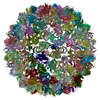
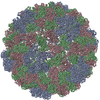
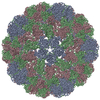
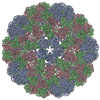
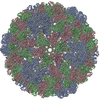
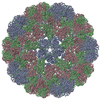
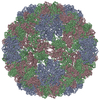
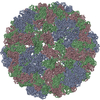
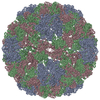
 PDBj
PDBj

